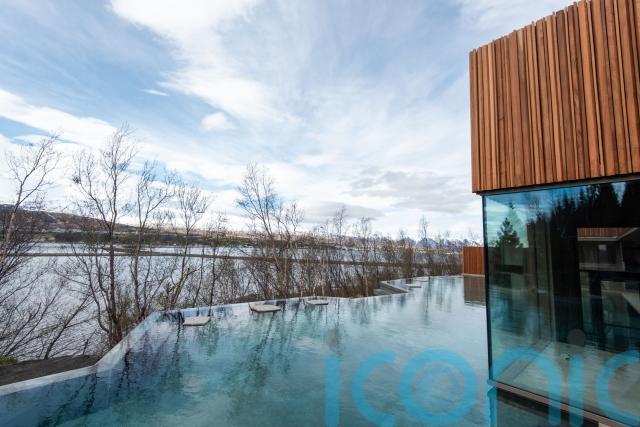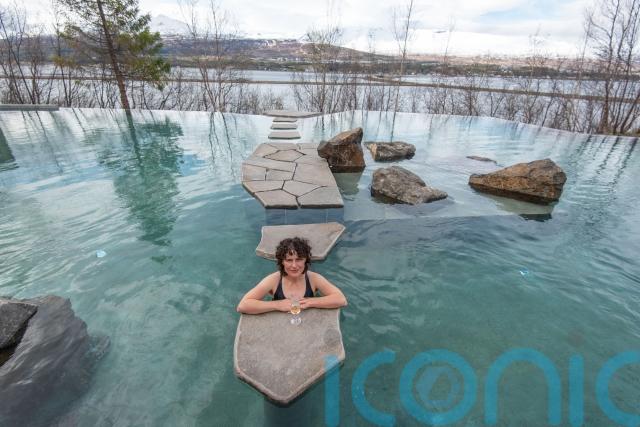
Bubbling both below and above the surface, volcanic activity has defined Iceland’s landscape. Lava fields tangle from the foot of gas-spewing peaks and steam spurts from cracks in the ground.
Naturally, the Earth’s non-stop rumblings have shaped a national culture too.
Bathing in hot springs is a tradition stretching back centuries. From dipping in hidden lagoons to pumping heated water into purpose-built pools, Icelanders have harnessed the power of geothermal energy to create one of the country’s biggest national pastimes.
The Blue Lagoon in Keflavik, close to Iceland’s main international airport, has been declared a world wonder for it’s therapeutic silica-rich waters. But it’s not the only super spa in the land of fire and ice.
Recently opened, the Forest Lagoon in Akureyri is setting a new standard for Icelandic hot springs. Here’s why everyone’s so excited about the new bathing spot in the north…
Where is it?

Harsh winds prevent trees from growing too tall in Iceland, making forests a rarity. But this nature-driven, purpose-built spa, which opened last month, makes the most of what’s available by occupying one of the few leafy sites in the north.
Although perhaps not so much of a novelty for Brits who’ve grown up surrounded ancient oaks, there is another benefit to the choice of setting. Along with the sweet smell of sap and earthy moss, the natural attraction of the location is its sheltered position – exceptional in a country where winds can gust up to 70mph.
Is it easy to reach?
While many of Iceland’s hot springs are hidden in (almost) inaccessible places, this one is a doddle to find. Overlooking the 60km Eyjafjörður fjord – where humpbacks regularly migrate to feed – it’s across the water from mountain-backed capital of the north, Akureyri.
In fact, it’s possible to leave home in the UK and be bathing a few hours later, thanks to a new direct flight from Niceair (niceair.is), launching June 3. (A direct link to Manchester will follow in October.)
What’s it like?
The lagoon is divided between two main pools – heated to 39C and 41C. Inside, a wooden glass-fronted sauna looks onto the water, framing a view of snow-dusted mountains and deciduous trees, whose boughs rotate through a seasonal palette of golds, bronzes, silvers and greens.
So what else makes it so special?
It might sound a bit technical, but having 27 outlets pumping water into the lagoon is a game-changer, allowing water to flow evenly, so there are no annoying cold patches to surprise you.
A choice of two swim-up bars avoids long queues. Plus it’s open until midnight – later than any other purpose-built lagoon in Iceland – meaning you can stay out later to watch the midnight sun or catch a glimpse of the northern lights, depending on the time of year.
How’s it different to the Blue Lagoon?

Although built by the same design team, BASALT Architects, the main difference is… it isn’t blue. While water flowing from lava fields into Keflavik’s world-famous attraction is rich in silica (giving it a distinctive milky blue colour), at Forest Lagoon it’s simply a mountain spring heated by energy from the Earth’s core. The source was discovered during digging for a new toll tunnel in 2015, now part of Iceland Ring Road Route 1.
General manager Tinna Jóhannsdóttir claims the water still contains beauty-boosting minerals collected on its journey through millennia-old basalt rocks. But the main wellbeing benefit is simply the relaxing sensation of bathing in a hot spring.
Myvatn Nature Baths, Myvatn
GeoSea, Husavik
SkyLagoon, Reykjavik
How to plan your trip
Discover The World (discover-the-world.com; 01737 214 250) offer a 4-night North Iceland Adventure summer holiday from £1031pp including B&B hotels, car hire and flights with Niceair from London Stansted to Akureyri.
Subscribe or register today to discover more from DonegalLive.ie
Buy the e-paper of the Donegal Democrat, Donegal People's Press, Donegal Post and Inish Times here for instant access to Donegal's premier news titles.
Keep up with the latest news from Donegal with our daily newsletter featuring the most important stories of the day delivered to your inbox every evening at 5pm.